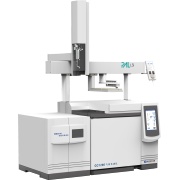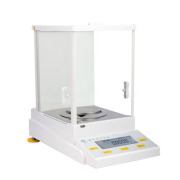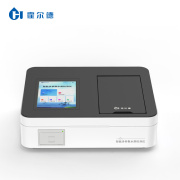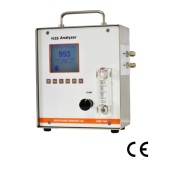进口
仪器简介:
Q-Sense D300 is the system of choice to get detailed information about
complex surface chemistry or biology. When you need to know how
molecules adsorb to a chosen surface or need to examine the difference
between two very similar approaches for a polymer-based biomaterial,
the QCM-D technique provides crucial information about mass and
structural changes taking place at the surface. Q-Sense D300 is a
complete system including support, software and hardware.
It is flexible and may be customized to handle for example flow
measurements. Real time analysis Reactions are followed as they
happen. Every second multiple frequency and dissipation data are
acquired which are related to mass and viscoelastic changes of
layer/layers adsorbing to or desorbing from the sensor.
High sensitivity The maximum sensitivity is 1 ng/cm2 allowing studies
of molecules with Mw below 500 Dalton (depending on surface coverage).
Structural changes can be studied in great detail as well.
Flexible choice of surface Since QCM-D is an electro-mechanical
method any surface can be used if it can be coated as a thin (<10 µm)
homogeneous film on top of the sensor electrodes.
Viscoelastic properties The included software, QTools,enables
accurate estimations of thickness and viscoelastic properties even
for soft films based on multi-frequency (5, 15, 25 and 35 MHz)
data achieved with the Q-Sense D300.
技术参数:
QSoft 301 Operating system Windows 98/ME/NT/2000/XP Interface Parallel port on any regular PC (optimised for Dell)
Maximum output rate, 1 frequency - 15 data points per second Normal rate, low noise, 4 frequencies - 4 data points per second and frequency (5, 15, 25 and 35 MHz) QTools Viscoelastic models incorporated Voight/Maxwell for frequency and dissipation response of applied films Picture formats Bitmap, Metafile, Enhanced Metafile, JPEG Input data Frequency and dissipation data from min. 2, preferable ≥3 frequencies
Output data Modeled values of density, shear modulus, viscosity and thickness
主要特点:
FREQUENCY AND DISSIPATION CHARACTERISTICS
Frequency range 1-42 MHz Frequency resolution 0.01 Hz
Mass resolution 1,8 pg / mm2 or 0,18 ng/cm2
using Sauerbrey relation for a 5 MHz crystal
Dissipation resolution 1x10-9 Active sensor area 7 mm2
Measurement conditions 1 datapoint / 5 seconds, 20-37 °C,
water Smallest detectable change in f* 0.05 Hz corresponding to 0.9 ng/cm2 (9 pg/mm2)
Smallest detectable change in D* 0.04 x 10-6
Measurement conditions: 4 datapoints / second, 20-37 °C, water Smallest detectable change in f* 0.2 Hz, corresponding to 3.5 ng/cm2 (35 pg/mm2)
Smallest detectable change in D* 0.1 x 10-6 * As comparison, binding of Myoglobin, a small globular protein (Mw 17.8 kD) that forms a rigid monolayer, gives a frequency response of 10 Hz and a Dissipation of 0.2 x 10-6. Mefp-1,
an elongated protein (Mw 120 kD) forming a soft structure, has a corresponding dissipation of ~ 12 x 10-6 and a frequency response of 60 Hz.
Max load - 0.1 mg/cm² Max film thickness - 10 µm (depending on the viscoelastic properties of the material)
Q-Sense D300 is the system of choice to get detailed information about
complex surface chemistry or biology. When you need to know how
molecules adsorb to a chosen surface or need to examine the difference
between two very similar approaches for a polymer-based biomaterial,
the QCM-D technique provides crucial information about mass and
structural changes taking place at the surface. Q-Sense D300 is a
complete system including support, software and hardware.
It is flexible and may be customized to handle for example flow
measurements. Real time analysis Reactions are followed as they
happen. Every second multiple frequency and dissipation data are
acquired which are related to mass and viscoelastic changes of
layer/layers adsorbing to or desorbing from the sensor.
High sensitivity The maximum sensitivity is 1 ng/cm2 allowing studies
of molecules with Mw below 500 Dalton (depending on surface coverage).
Structural changes can be studied in great detail as well.
Flexible choice of surface Since QCM-D is an electro-mechanical
method any surface can be used if it can be coated as a thin (<10 µm)
homogeneous film on top of the sensor electrodes.
Viscoelastic properties The included software, QTools,enables
accurate estimations of thickness and viscoelastic properties even
for soft films based on multi-frequency (5, 15, 25 and 35 MHz)
data achieved with the Q-Sense D300.
技术参数:
QSoft 301 Operating system Windows 98/ME/NT/2000/XP Interface Parallel port on any regular PC (optimised for Dell)
Maximum output rate, 1 frequency - 15 data points per second Normal rate, low noise, 4 frequencies - 4 data points per second and frequency (5, 15, 25 and 35 MHz) QTools Viscoelastic models incorporated Voight/Maxwell for frequency and dissipation response of applied films Picture formats Bitmap, Metafile, Enhanced Metafile, JPEG Input data Frequency and dissipation data from min. 2, preferable ≥3 frequencies
Output data Modeled values of density, shear modulus, viscosity and thickness
主要特点:
FREQUENCY AND DISSIPATION CHARACTERISTICS
Frequency range 1-42 MHz Frequency resolution 0.01 Hz
Mass resolution 1,8 pg / mm2 or 0,18 ng/cm2
using Sauerbrey relation for a 5 MHz crystal
Dissipation resolution 1x10-9 Active sensor area 7 mm2
Measurement conditions 1 datapoint / 5 seconds, 20-37 °C,
water Smallest detectable change in f* 0.05 Hz corresponding to 0.9 ng/cm2 (9 pg/mm2)
Smallest detectable change in D* 0.04 x 10-6
Measurement conditions: 4 datapoints / second, 20-37 °C, water Smallest detectable change in f* 0.2 Hz, corresponding to 3.5 ng/cm2 (35 pg/mm2)
Smallest detectable change in D* 0.1 x 10-6 * As comparison, binding of Myoglobin, a small globular protein (Mw 17.8 kD) that forms a rigid monolayer, gives a frequency response of 10 Hz and a Dissipation of 0.2 x 10-6. Mefp-1,
an elongated protein (Mw 120 kD) forming a soft structure, has a corresponding dissipation of ~ 12 x 10-6 and a frequency response of 60 Hz.
Max load - 0.1 mg/cm² Max film thickness - 10 µm (depending on the viscoelastic properties of the material)
石英晶体微天平 Quartz Crystal Microbalance(QCM)信息由翰光高科技股份有限公司为您提供,如您想了解更多关于石英晶体微天平 Quartz Crystal Microbalance(QCM)报价、型号、参数等信息,欢迎来电或留言咨询。
相关产品



 仪器对比
仪器对比




 关注
关注









